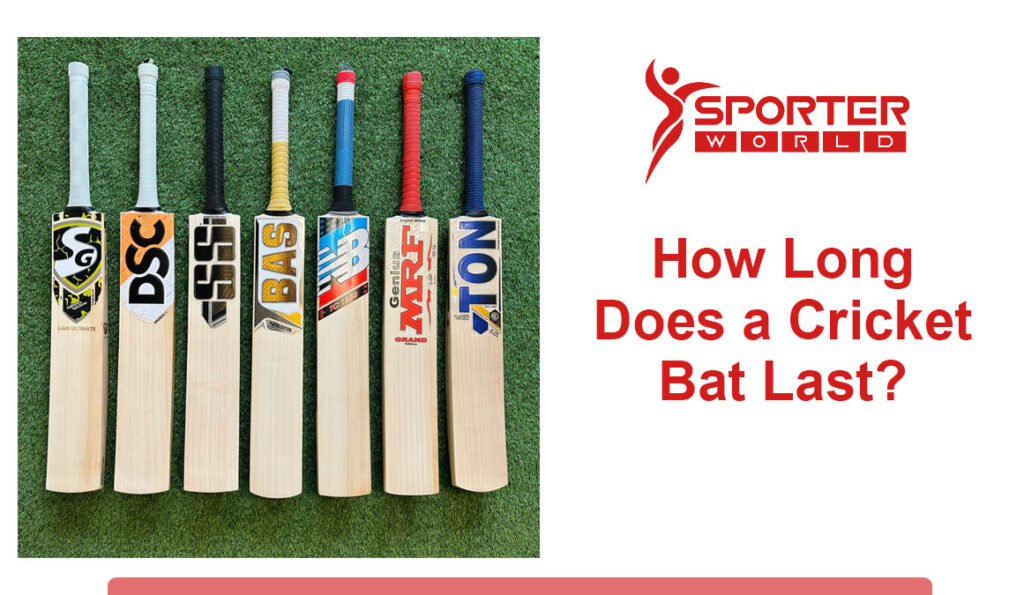Do you have a cricket bat that you cherish and want to keep in top condition for as long as possible? Maintaining your cricket bat is crucial for its longevity and performance. Whether you’re a professional player or just a cricket enthusiast, knowing how to care for your bat properly can significantly affect its lifespan.
No one wants to spend their hard-earned money on a cricket bat only to have it worn out or damaged after a few matches. So, if you want to maximize the lifespan of your cricket bat, this article is for you. I will provide you with essential tips and techniques to maintain your cricket bat and ensure it stays in excellent condition for a long time.
By following the guidelines I’ll outline in this article, you’ll prolong the life of your cricket bat and enhance its performance on the field. From proper storage to regular maintenance routines, I’ll equip you with the knowledge to keep your beloved cricket bat in top shape for many seasons.
How Long Does a Cricket Bat Last?

A cricket bat can last multiple years if it is only used for a specific purpose. A cricket bat should typically last about 1000-1500 runs with practice included. This may vary for individual players as the longevity of a bat also depends on how they use and maintain it. Proper care using oil and knocking-in techniques will add to its durability and extend its lifespan for up to three or four seasons.
On the other hand, not minding the maintenance procedures can drastically reduce a bat’s life cycle. Overusing the surface while practicing, storing the bats in moist places, and avoiding necessary repairs could lead to quick deterioration of the bat. More often than not, too much net practice hurts the lifespan of a cricket bat and causes irreversible damage to it. Thus, good maintenance techniques are essential to increasing longevity and making sure that your cricket bat lasts over time without any damage.
You May Also Like: 10 Tips to Improve Your Cricket Wicket-Keeping Skills
5 Effective Ways to Maintain Cricket Bats for Longevity
1. Oiling
Properly caring for your cricket bat is essential to its longevity and effectiveness. Oiling your bat with cricket bat oil or linseed oil is a crucial part of routine maintenance that can drastically improve its performance on the field. Not only does oil help protect the wood from external moisture, but it also helps maintain the natural internal moisture level. To achieve this, lightly sand your new, natural-faced bat with 150-grit sandpaper before applying a thin layer of linseed oil all over the face. After coating the bat, please leave it to dry for 24 hours before use to ensure maximum protection during play. Linseed oil is widely available from any good cricket shop in Perth, so no matter what time of year you are in town, you can find what you need for proper equipment maintenance.
2. Knocking In
Knocking in your cricket bat is time-consuming and requires patience and dedication. It is essential for both the longevity and performance of your bat, as it helps to reduce the chances of damage and warping during play. The knocking-in process involves carefully hitting the face of the bat with a mallet or rubber hammer to soften and compress the wood fibers. This helps reduce the risk of moisture damage and ensures that your bat is well-prepared for top-notch performance on the field.
3. Protecting against Moisture
Moisture can be a cricket bat’s worst enemy, so protecting your bat from the elements is important. If you are playing during wet or humid conditions, it’s recommended that you use an anti-moisture sheet to cover your bat. This will help keep the moisture away from the wood and reduce the chances of damage. After play, store your cricket bat in a dry place and allow it to air out before putting it away.
4. Proper Storage
When not in use, your cricket bat should be stored in a dry and cool place. Never store your cricket bat in a damp environment, as this can lead to warping and damage. Investing in a quality bat cover can help protect your bat from the elements and prolong its lifespan. In addition, make sure to store your bat away from direct sunlight to avoid fading and discoloration.
5. Regular inspection
Regular Cricket bat inspection is essential to keep your bat’s performance up and ensure it can last you for a long time. This includes regularly checking for any cracks or dents that may have formed while it’s being played with or stored away. If you notice any damage, it’s important to act quickly and get it repaired to prevent the damage from worsening. You can easily sand down small cracks using significantly fine sandpaper, ensuring a gentle sweeping motion with the grain of the wood rather than against it, and then apply either protective facing or fiberglass tape on top of the crack.
How do I know if my bat needs oiling?
Bats, whether for cricket or baseball, typically do not require oiling like wooden tools or instruments. Instead, they need proper maintenance and care to perform at their best. Here are some guidelines to help you determine if your bat needs attention:
- Inspect for Damage: Regularly examine your bat for any signs of damage, such as cracks, dents, or splinters. If you notice any of these issues, addressing them immediately is crucial. Damaged bats can be unsafe to use and may affect performance.
- Check for Wear: Over time, bats may experience wear on the hitting surface, especially with cricket bats. Look for flat spots or areas where the wood seems worn down. If you see significant wear, it may be time to consider refinishing or repairing the bat.
- Grip Condition: The grip or handle of the bat can wear out or become damaged. If the grip is torn, loose, or uncomfortable to hold, replacing it is a good idea. A secure and comfortable grip is essential for control and safety.
- Balance and Weight: Pay attention to how the bat feels during play. If you notice a significant change in the balance or weight distribution, it could be a sign of internal damage or wear. In such cases, it may be necessary to have the bat professionally evaluated.
- Performance: The most critical indicator of a bat’s condition is its performance. If you notice a drop in your batting average or if the ball is not coming off the bat as it used to, it might be time to consider getting a new bat or having your current one inspected.
- Cleaning and Maintenance: Keep your bat clean and dry. Use a soft cloth to wipe off dirt and sweat after each use. Avoid exposing it to extreme temperatures or moisture, as these can damage the wood.
- Professional Inspection: If you have concerns about your bat’s condition, it’s a good idea to seek the advice of a professional bat maker or repair specialist. They can assess the bat’s integrity and recommend necessary repairs or maintenance.
Remember that wooden bats can have a finite lifespan and may eventually need replacement. Proper care and regular inspection can help prolong the life of your bat and ensure it performs at its best.
What essential oil is good for bats?
Using essential oils to maintain a cricket bat for longevity is becoming an increasingly popular practice among cricket players. Essential oils have natural properties that can help protect and extend the life of a cricket bat.
Tea tree oil, also known as melaleuca, is one of the most common essential oils used to care for cricket bats. Tea tree oil contains antiseptic and anti-fungal properties that can help keep the bat free from mold and mildew, reduce odors, and protect it from weathering. Other popular essential oils for cricket bats include cedarwood, lavender, and lemon.
Frequently asked questions
FAQ 1: How often should I oil my cricket bat?
Answer: It is recommended to oil your cricket bat every few months or at the beginning of each season. This helps to maintain the moisture content, prevent cracking, and enhance its durability.
FAQ 2: Which oil is best for cricket bat maintenance?
Answer: The best oil for cricket bats is raw linseed oil. It is a natural material that penetrates the wood fibers, keeping them supple and resilient. Avoid using excessive oil, as it may affect the bat’s performance.
FAQ 3: How should I apply oil to my cricket bat?
Answer: Apply a thin coat of raw linseed oil using a soft cloth or sponge. Ensure an even application, covering the face, edges, and back of the bat. Leave it to dry in a horizontal position, away from direct sunlight, for optimal absorption.
FAQ 4: Should I knock-in my cricket bat before using it?
Answer: Yes, it is essential to go through the knocking-in process to prepare your cricket bat for play. Use a wooden mallet to gently strike the bat’s surface, increasing the wood’s density and minimizing the risk of cracking during play.
FAQ 5: How often should I reapply oil to my cricket bat?
Answer: After knocking in the bat, apply 3-4 initial coats of linseed oil, allowing it to dry between each coat. Subsequently, a light coat of oil can be applied every few months or whenever the bat appears dry.
Conclusion
Proper care and maintenance is essential for prolonging the life of your cricket bat. Clean it regularly, seek expert advice when needed, knock on the bat before playing, and apply a light coat of oil periodically. Following these steps will ensure your cricket bat performs at its best and lasts many years.



